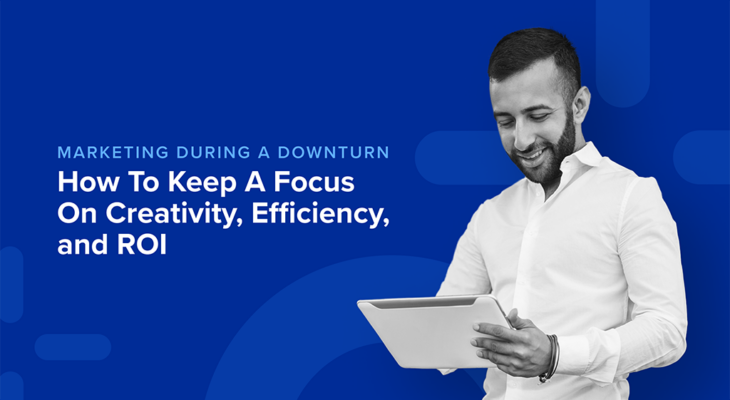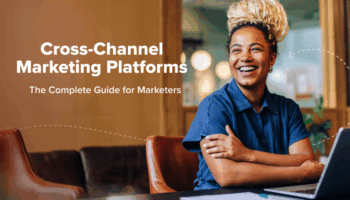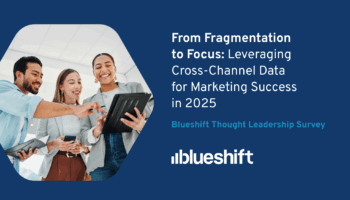Some economists suggest that the US will be in a recession within the next few months. At this point, no one is sure. What does this mean for marketers, especially B2C marketers? Keeping a focus on creativity, efficiency, and ROI, and taking a customer-first approach have never been more important. It’s also wise not to wait it out. Brands that continue to innovate will gain momentum over their competitors in the long run.
5 Actions for B2C Marketers During an Economic Downturn

ACTIONS FOR B2C MARKETERS
5 Strategies To Take During An Economic Downturn
We’ve compiled a list of five strategies that you can take now to continue to grow and innovate for your customers during economic turbulence.
SPEND WISELY
1. Be Ruthless With ROI
Marketing spend is an investment. This means that it’s up to the CMO to make a business case for the investment and prove out the impact of each marketing activity on pipeline and revenue. It’s now critical for CMOs to be consistently engaged with their CFOs and CEOs around efficiency, growth, and revenue. CFO and CMO alignment is the hot topic on every CMO discussion I’ve been involved in lately.
Even with the uncertainty about the economy, the latest reports from marketers show that marketing budgets are on the rise. But the need to show ROI is critical. According to Forrester, the focus in 2023 should be on shifting your investments toward measurable and reliable touchpoints where you can increase customer engagement, cut marketing investments that create hurdles for flexibility and authenticity, and stay innovative with new technologies.
I started as Blueshift’s CMO six months ago. The first thing I did was to figure out what channels were working that we could optimize, what we needed to cut or scale down, and what we needed to purchase to stay innovative. You need to look at it channel by channel, but you also need to look at your strategy holistically both within and outside of marketing. If paid media is costing too much, then consider if you need to focus on your brand to ensure that when people see your name, it’s not their first introduction. Does your chat strategy align with the sales process? Is your content too focused on top of funnel or bottom of funnel for your pipeline goals? And with all of this, what can you do to drive ROI and efficiency as well as innovation?
SMARTER ENGAGEMENT
2. Keep Your Friends Close With First-Party Data
Today’s marketers have an opportunity to do better. Every time you connect with a customer, that moment of connection creates a piece of data. That data tells you about the customer’s interest and intentions. You can use that data to deliver a smarter engagement back to the customer, and then that creates customer delight which leads to more data and so on.
Of course, I can’t talk about data without mentioning the death of the cookie. That’s all we’ve heard about over the last year or so. (Check out the first-party data session now on demand from our recent Engage customer event.) The demise of third-party data is a good thing. As consumers, who wants to be tracked? We want to be engaging with brands in a trusted form. The idea of first-party data that’s collected through trust and consent with the brands that you love becoming more important is fantastic. Gartner told us last year that marketing leaders need to effectively manage first party data.
I still see a lot of brands that are just beginning the journey and struggling to activate first-party data because their data is siloed. They’re leaving behind data within their organizations. As marketers, we want unified, rich customer data at our fingertips without the need to go to IT or another team to get that data. We also need timely data to help us understand our customers better in the moment.
How do marketers easily get this data quickly? There are three building blocks. The first is having data that’s easily accessible to marketers. Second is about making the identity actionable, so it’s not just an abstract concept, but it’s something that you can act on and actually connect with real people. And finally, you need to have automation, which puts that data to work for you and drives the business forward.
CUSTOMER MOMENTS
3. Create Wow Moments Using AI
Casting a broad net, especially during an economic downturn, results in unsubscribes, blocks, negative brand image, and more. AI unlocks customer-centric experiences. The role of AI for marketers is really about how to deliver that next-best experience to each and every customer, and the components of that are the who, what, when, and where of marketing.
The who is all about who to target: how do we segment customers with precision, how do we know their lifecycle stage, and how do we know where they are in their self-directed customer journey? The second one is all about what to recommend now that we understand where the customer is in their journey with us. What do we say in our message back to them? Should we put an offer in front of them? Should we give them another piece of content? Do we try to sell them a product? Do we try to advance their customer journey in some form?
Next, we need to understand when to engage and where to connect with customers because again, it’s a cross-channel world. It’s an always-on world. People are always connected. It’s a chance to engage with them, whether by email, SMS, push notifications, in-app messages, web content, paid media, direct mail, and more. But when’s the optimal time that they will be responsive to your messages? When can you interrupt them without annoying them? This becomes critical. And how do you think about where to connect with them on this cross-channel engagement cycle when you not only have many digital channels but also many offline channels and human-assisted channels.
So really the role of AI is to figure out who, what, when, and where.
WORK EFFICIENTLY
4. Keep It Simple by Choosing an Integrated Platform Approach
For this year’s marketing technology landscape, Chiefmartec’s Scott Brinker and team reported 9,932 martech solutions available to marketers. In 2011, there were around 150. With this many choices, it’s important to be smart about your selection. Choose a technology that does more than one thing and not tons of point solutions. The more technologies you have, the more complex your martech stack becomes.
With a platform approach, you gain agility, scale, and reduce costs. This becomes an easier conversation with your CFO because the ROI on a platform can save on integration costs, resources, and more. It’s also an easier conversation with your IT team because an integrated platform works seamlessly, you have fewer solutions to manage and you can scale.
A platform approach makes it easier than ever to create a smooth cross-channel experience for your customers. You can take all of the data from your CX channels, unify it, supercharge it with AI-powered personalization, and then create connected cross-channel campaigns. Now you can truly understand the customer and take that knowledge to all the relevant marketing channels.
GIVE CUSTOMERS WHAT THEY NEED
5. Stay Human With Your Customer Interactions
People are busier than ever. They want a connection to their trusted brands. As you use rich data to understand your customers, use AI to deliver meaningful engagement, and meet your customers across channels, it’s important that your brand connects with your customers on a human level. This might include sharing educational content, social values content, employee community information, customer stories, and more. You also want to create a forum where your customers can connect with each other and build a strong community. This is an extension of your brand. A brand is a personality. Deloitte talks about marketers creating the human experience. For the relationship with your customer to be meaningful, they need to connect with you beyond the product purchase and into the human experience.
Now that I’ve been with Blueshift for six months, I see customers taking marketing to the next level. A great example is LendingTree. By leveraging rich data and insights in each stage of the customer journey, LendingTree has seen a 17% increase in monthly active users and a 48% increase in open rates.
Learn more about creating a connected cross-channel marketing strategy, rich customer data, and personalization with AI marketing though Blueshift’s intelligent engagement platform.
Joan Jenkins is CMO of Blueshift
BLUESHIFT WEBINAR
Marketing In An Economic Downturn
Join our live, interactive webinar and learn how to collect and activate rich actionable data to deliver the right message at the right time. Hear from Joyce Poole, senior director of marketing CRM at LendingTree, and Joan Jenkins, CMO at Blueshift.
Wednesday, December 6, 2022 at 9am PT / 12pm ET


